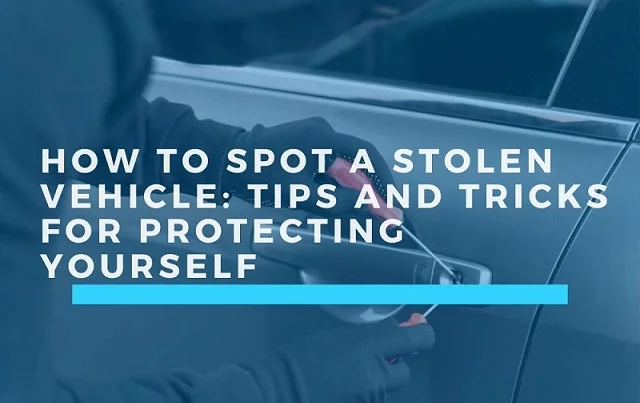In today’s world, where vehicle thefts are common, it is crucial to know how to spot a stolen vehicle. Whether you are in the market to buy a used car or want to ensure the security of your vehicle, understanding the signs of a stolen car and knowing how to perform a stolen car by VIN check can save you from potential headaches and financial loss. In this blog, we will explore valuable tips and tricks to help you protect yourself from being a victim of vehicle theft. We will also discuss the importance of performing a stolen car VIN check on a used vehicle before purchasing. So, let’s dive in and learn how to stay one step ahead of car thieves.
Recognizing Signs of a Stolen Vehicle
If you are a used car buyer, there are some signs you can pay attention to while you’re out there in the market. Whenever these signs are spotted, you should be able to tell immediately if the vehicle you are interested in is stolen or not. Some of these signs are:
Physical signs and damages
Stolen vehicles are often characterized by signs that show that the vehicle was broken into or that there was a struggle, and if you look closely, you just may see the signs and avoid getting stuck with a stolen car. Imagine driving your vehicle on the highway and getting stopped by the police for driving a stolen vehicle. No one wants that, right? So what are these signs?
- Altered or damaged ignition systems: Look for broken locks, punched keyholes, or a different ignition switch from the original. If you find any of these, then you can suspect that the vehicle is stolen.
- Mismatched or tampered VIN plates: Inspect the VIN plate on the dashboard, door frame, and engine bay. Look for signs of tampering, mismatched rivets, or suspicious alterations. If a vehicle has mismatched plates, it just has to be a stolen vehicle. The VIN is one of the easiest ways to protect yourself from car scammers selling stolen vehicles, and we will discuss this further in this article.
- Scratched-off or replaced serial numbers: Examine major parts like the engine, transmission, and chassis for scratched-off or replaced serial numbers.
- Signs of forced entry: Check for damaged door locks, broken windows, or pry marks on the door frame.
These are the most common signs found on stolen vehicles. Keep an eye out, and make sure to walk away from any deal that looks a bit suspicious.
Read Also: Chassis Number vs. VIN: Are They the Same?
Suspicious Behavior
What else is a sign that the vehicle you are interested in is stolen? Look out for suspicious behavior! When the seller starts acting suspicious and refusing to share information on the vehicle, you should be aware that it may just be a stolen one. Some signs that your vehicle may be stolen include:
Lack of proper documentation: The seller may not have the vehicle title, registration, or maintenance records. In such situations, it could be that the stolen car didn’t come with its documents and paperwork is unavailable. To avoid buying a well-disguised stolen car, ensure the seller can provide valid paperwork.
Reluctance to allow vehicle inspection or test drive: A legitimate seller will allow you to thoroughly inspect the vehicle and take it for a test drive. Be cautious if the seller hesitates or denies these requests.
Unusually low price: If the price seems too good to be true, it’s worth investigating further. Stolen vehicles are sometimes sold at significantly lower prices to attract quick buyers.
Cash-only transactions or lack of receipt: Beware of sellers who insist on cash payments without providing a written receipt. Legitimate sellers should offer a proper transaction process.
When you are faced with a vehicle that has one or more of these signs, it is best to halt the car-buying process and verify the vehicle’s overall condition and stolen records. The easiest way to do this is with a stolen car VIN check.
ALSO READ: How To Do a Vintage Car VIN Lookup
What is a stolen car VIN check?
A stolen car VIN check is a process that involves decoding the Vehicle Identification Number (VIN) of the vehicle you are interested in and gaining full access to the vehicle’s specifications, history, and records. Detailed Vehicle History is one of the few vehicle history report providers that provides accurate and up-to-date information containing:
- Theft records
- Accident records
- Damage history
- Title brand records
- Lien and loan records
- Service history
- Maintenance schedules
- Ownership records
- Auction records with photos
- Sales records, and more.
With a stolen car VIN check, you can be sure that the car you are interested in is in good condition and is not stolen. A stolen car VIN check is one of the few tools that has proven to be effective in identifying stolen cars immediately. However, you also need to keep an eye out for the above-mentioned hints and tips. To check if the VIN is stolen, you need to identify a good VIN check tool that provides access to full vehicle specifications and records. Free stolen VIN check services are available, but they offer limited information, and you may not be able to get the best insights from them. So which is the best platform to check the VIN of a car and determine if it is stolen? The simple answer is Detailed Vehicle History.
Get a stolen car VIN check with Detailed Vehicle History
Whether you are interested in a stolen car VIN check, a stolen ATV VIN check, or you want to check the VIN number on a motorcycle to see if it’s stolen, Detailed Vehicle History has the tools you need. The VIN Check tool provided by Detailed Vehicle History, as mentioned above, is an accurate tool that easily checks the VINs of vehicles and returns their records instantly. To carry out a VIN check with our tool, all you need to do is follow these steps:
- Locate the VIN on the vehicle you are interested in. The VIN is usually found on the vehicle’s dashboard, driver’s side door jamb, Certificate of title, insurance documents, and more.
- Visit the Detailed Vehicle History website.
- Navigate to the VIN check tool and fill out the provided form with the required information.
- Ensure that the VIN of the car you are interested in is correctly entered into the form. For ease of access, Detailed Vehicle History has a mobile application available in both Android and iOS versions that can scan the VIN and carry out stolen car VIN checks as accurately as the web application does.
After entering (or scanning) the VIN of the car, proceed to generate your vehicle history report and confirm if your vehicle is a stolen one or not.
With the information contained in a vehicle history report from Detailed Vehicle History, you can easily confirm if your vehicle is stolen or not. If it happens not to be stolen, the other details on the report will tell you if the car is reliable enough for purchase or not.
Additional Tips and Tricks for Vehicle Owners
Vehicle Security Systems
Parking in Well-Lit Areas
Secure valuables and documents
Never leave valuable items or important documents, such as registration and insurance papers, inside the vehicle. Take them with you or store them in a secure location to prevent theft and identity-related crimes.
Vehicle Visibility
Always lock your vehicle when leaving it unattended, even for a short period. Close all windows and sunroofs to reduce the chances of unauthorized access. Avoid leaving spare keys or key fobs inside the vehicle.
ALSO READ: 5 Carfax Alternatives To Check Vehicle History (2023)
Community Watch
Purchase from Reputable Sources
For car buyers, when the time comes to buy a used vehicle, always opt for reputable dealerships or private sellers with a proven track record. Research the seller’s background, read reviews, and ask for vehicle history reports. Verify the seller’s identity and ensure they have the necessary paperwork for the vehicle. If you want to use a classifieds marketplace, we would recommend FindUsedOnline, as they offer detailed vehicle history reports and you can make the best decisions there.
Protecting yourself from vehicle theft requires a combination of awareness, caution, and proactive measures. By being vigilant and following the detailed tips discussed in this article, you can increase your chances of spotting a stolen vehicle. Remember to carry out a comprehensive stolen car VIN check before purchasing any used vehicle, uncover any hidden history, and verify its legitimacy.









